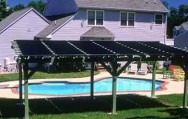
There are some design factors to be considered, including proper sizing and location. But there are many web sites to help you, as well as the off-grid technical forum for advice. It’s not imperative to have your solar pool heater configured and installed by experts.
Fossil fuels are expensive and release carbon dioxide, a potent greenhouse gas. Air-source heat pumps consume electricity and tend to be noisy. The best option is a solar thermal system using evacuated vacuum tubes. In this system, radiant energy from the sun enters a glass vacuum tube where it heats a core. In turn, this heats the pool water flowing past it. Because all the air has been evacuated from the tube, energy enters the tube but can not readily escape, meaning more energy enters the system.
While a solar thermal pool heater may initially cost a little more than a common gas-powered heater, it requires no fuel to operate and will typically pay for itself in 2-3 years
depending on local power prices, leaving you with many years of free heating. Because the tubes are round, they receive sunlight from many angles so it’s not strictly necessary to have them facing south. Since the pool’s water pump already circulates water, there are no additional moving parts, making the system virtually maintenance free.Solar thermal pool heaters are good for the environment too. According to Natural Resources Canada, compared to natural gas heating, a solar thermal system may prevent three to 10 tons of carbon dioxide from reaching the atmosphere in a typical swimming season.